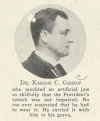Maxillary Prosthetics, Speech Impairment, and Presidential Politics: How Grover Cleveland Was Able to Speak Normally after His "Secret" Operation
- PMID: 31799404
- PMCID: PMC6887570
- DOI: 10.1055/s-0039-3400537
Maxillary Prosthetics, Speech Impairment, and Presidential Politics: How Grover Cleveland Was Able to Speak Normally after His "Secret" Operation
Abstract
In the summer of 1893, President Grover Cleveland discovered a mass on the roof of his mouth. Two physicians examined it, determined that it was a neoplasm, and recommended resection. In an effort to avoid revealing the illness to the public, the President and his doctors boarded a yacht on July 1 1893, where the surgeons resected the affected portion of his maxilla and several teeth under an ether anesthetic. Afterward, Kasson C. Gibson, a New York dentist, created a rubber obturator, which was placed in the surgical defect in the maxilla and restored the President's facial contour and speech. Due to the precise reconstruction with the rubber appliance crafted by Gibson, the President lived the rest of his public life without facial or speech abnormality. This article will review the details of the work of Kasson Gibson and the President's maxillary prosthesis.
Keywords: Grover Cleveland; Kasson Gibson; maxillary resection; oral surgery.
Conflict of interest statement
Conflict of Interest None.
Figures





References
-
- Grover Cleveland's Career and Services.Twice President and Once Governor of New York. Vindication of his PoliciesGrover Cleveland's Career and Services. The Washington Post; 1908 Jun 25:3
-
- O'Reilly R M, Bryant J D.Letter from Robert Maitland O'Reilly to Joseph Bryant and William W. Keen regarding health of PresidentIn:, ed.Philadelphia, PA: Historical Medical Library of the College of Physicians of Philadelphia; 18934
-
- Gibson K C. Philadelphia, PA: Historical Medical Library of The College of Physicians of Philadelphia; 1916. Press clippings: Assembled newspaper accounts of Kasson C. Gibson's involvement with President Cleveland's surgery, spanning 1893 September 19–1894, 1907, circa 1916.
-
- Bryant J D. Philadelphia, PA: Historical Medical Library of The College of Physicians of Philadelphia; 1905. Letter from Joseph Decatur Bryant to Colonel Daniel Lamont and William Williams Keen regarding secrecy surrounding President Cleveland's surgery, 1905 May 9–1905 July 6.
-
- Summers J C.Com. E. C. Benedict, Veteran Yachtsman The Rudder 191632261–266.. Available at,https://books.google.com/books?id=nsU6AAAAMAAJ&pg=PA261#v=onepage&q&f=false
LinkOut - more resources
Full Text Sources

